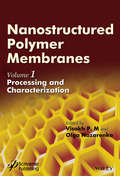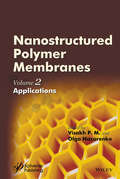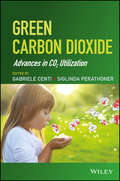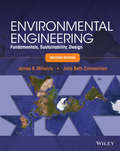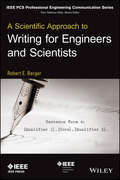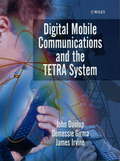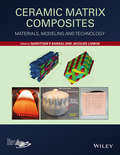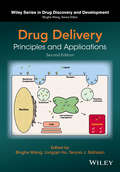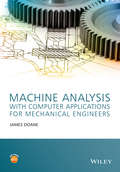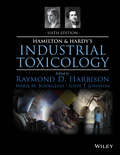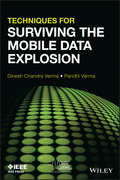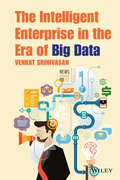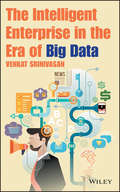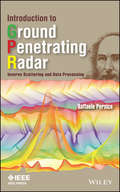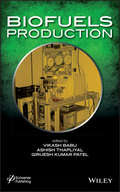- Table View
- List View
Nanostructured Polymer Membranes, Volume 1: Processing and Characterization
by Visakh P. M. Olga NazarenkoThis book is intended to serve as a "one-stop" reference resource for important research accomplishments in the area of nanostructured polymer membranes and their processing and characterizations. It will be a very valuable reference source for university and college faculties, professionals, post-doctoral research fellows, senior graduate students, and researchers from R&D laboratories working in the area of polymer nanobased membranes. The various chapters are contributed by prominent researchers from industry, academia and government/private research laboratories across the globe and comprise an up-to-date record on the major findings and observations in the field.
Nanostructured Polymer Membranes, Volume 1: Processing and Characterization
by Visakh P. M. Long Yu Olga NazarenkoThis book is intended to serve as a "one-stop" reference resource for important research accomplishments in the area of nanostructured polymer membranes and their processing and characterizations. It will be a very valuable reference source for university and college faculties, professionals, post-doctoral research fellows, senior graduate students, and researchers from R&D laboratories working in the area of polymer nanobased membranes. The various chapters are contributed by prominent researchers from industry, academia and government/private research laboratories across the globe and comprise an up-to-date record on the major findings and observations in the field.
Nanostructured Polymer Membranes, Volume 2: Applications
by Visakh P. M. Olga NazarenkoThe 2nd volume on applications with discuss the various aspects of state-of-the-art, new challenges and opportunities for gas and vapor separation of polymer membranes, membranes for wastewater treatment, polymer electrolyte membranes and methanol fuel cells, polymer membranes for water desalination, optical, electrochemical and anion/polyanion sensors, polymeric pervaporation membranes, organic-organic separation, biopolymer electrolytes for energy devices, carbon nanoparticles for pervaporation polymeric membranes, and mixed matrix membranes for nanofiltration application.
Nanostructured Polymer Membranes, Volume 2: Applications
by Visakh P. M. Long Yu Olga NazarenkoThe 2nd volume on applications with discuss the various aspects of state-of-the-art, new challenges and opportunities for gas and vapor separation of polymer membranes, membranes for wastewater treatment, polymer electrolyte membranes and methanol fuel cells, polymer membranes for water desalination, optical, electrochemical and anion/polyanion sensors, polymeric pervaporation membranes, organic-organic separation, biopolymer electrolytes for energy devices, carbon nanoparticles for pervaporation polymeric membranes, and mixed matrix membranes for nanofiltration application.
Green Carbon Dioxide: Advances in CO2 Utilization
by Gabriele Centi Siglinda PerathonerPROMISING NEW APPROACHES TO RECYCLE CARBON DIOXIDE AND REDUCE EMISSIONS With this book as their guide, readers will learn a variety of new approaches and methods to recycle and reuse carbon dioxide (CO2) in order to produce green fuels and chemicals and, at the same time, minimize CO2 emissions. The authors demonstrate how to convert CO2 into a broad range of essential products by using alternative green energy sources, such as solar, wind, and hydro-power as well as sustainable energy sources. Readers will discover that CO2 can be a driving force for the sustainable future of both the chemical industry and the energy and fuels industry. Green Carbon Dioxide features a team of expert authors, offering perspectives on the latest breakthroughs in CO2 recycling from Asia, Europe, and North America. The book begins with an introduction to the production of CO2-based fuels and chemicals. Next, it covers such topics as: Transformation of CO2 to useable products through free-radical-induced reactions Hydrogenation of CO2 to liquid fuels Direct synthesis of organic carbonates from CO2 and alcohols using heterogeneous oxide catalysts Electrocatalytic reduction of CO2 in methanol medium Fuel production from photocatalytic reduction of CO2 with water using TiO2-based nanocomposites Use of CO2 in enhanced oil recovery and carbon capture and sequestration More than 1,000 references enable readers to explore individual topics in greater depth. Green Carbon Dioxide offers engineers, chemists, and managers in the chemical and energy and fuel industries a remarkable new perspective, demonstrating how CO2 can play a significant role in the development of a sustainable Earth.
Green Carbon Dioxide: Advances in CO2 Utilization
by Gabriele Centi Siglinda PerathonerPROMISING NEW APPROACHES TO RECYCLE CARBON DIOXIDE AND REDUCE EMISSIONS With this book as their guide, readers will learn a variety of new approaches and methods to recycle and reuse carbon dioxide (CO2) in order to produce green fuels and chemicals and, at the same time, minimize CO2 emissions. The authors demonstrate how to convert CO2 into a broad range of essential products by using alternative green energy sources, such as solar, wind, and hydro-power as well as sustainable energy sources. Readers will discover that CO2 can be a driving force for the sustainable future of both the chemical industry and the energy and fuels industry. Green Carbon Dioxide features a team of expert authors, offering perspectives on the latest breakthroughs in CO2 recycling from Asia, Europe, and North America. The book begins with an introduction to the production of CO2-based fuels and chemicals. Next, it covers such topics as: Transformation of CO2 to useable products through free-radical-induced reactions Hydrogenation of CO2 to liquid fuels Direct synthesis of organic carbonates from CO2 and alcohols using heterogeneous oxide catalysts Electrocatalytic reduction of CO2 in methanol medium Fuel production from photocatalytic reduction of CO2 with water using TiO2-based nanocomposites Use of CO2 in enhanced oil recovery and carbon capture and sequestration More than 1,000 references enable readers to explore individual topics in greater depth. Green Carbon Dioxide offers engineers, chemists, and managers in the chemical and energy and fuel industries a remarkable new perspective, demonstrating how CO2 can play a significant role in the development of a sustainable Earth.
Environmental Engineering: Fundamentals, Sustainability, Design
by James R. Mihelcic Julie B. ZimmermanEnvironmental Engineering: Fundamentals, Sustainability, Design presents civil engineers with an introduction to chemistry and biology, through a mass and energy balance approach. ABET required topics of emerging importance, such as sustainable and global engineering are also covered. Problems, similar to those on the FE and PE exams, are integrated at the end of each chapter. Aligned with the National Academy of Engineering’s focus on managing carbon and nitrogen, the 2nd edition now includes a section on advanced technologies to more effectively reclaim nitrogen and phosphorous. Additionally, readers have immediate access to web modules, which address a specific topic, such as water and wastewater treatment. These modules include media rich content such as animations, audio, video and interactive problem solving, as well as links to explorations. Civil engineers will gain a global perspective, developing into innovative leaders in sustainable development.
A Scientific Approach to Writing for Engineers and Scientists (IEEE PCS Professional Engineering Communication Series)
by Robert E. BergerA SCIENTIFIC APPROACH TO WRITING Technical ideas may be solid or even groundbreaking, but if these ideas cannot be clearly communicated, reviewers of technical documents—e.g., proposals for research funding, articles submitted to scientific journals, and business plans to commercialize technology—are likely to reject the argument for advancing these ideas. The problem is that many engineers and scientists, entirely comfortable with the logic and principles of mathematics and science, treat writing as if it possesses none of these attributes. The absence of a systematic framework for writing often results in sentences that are difficult to follow or arguments that leave reviewers scratching their heads. This book fixes that problem by presenting a “scientific” approach to writing that mirrors the sensibilities of scientists and engineers, an approach based on an easily-discernable set of principles. Rather than merely stating rules for English grammar and composition, this book explains the reasons behind these rules and shows that good reasons can guide every writing decision. This resource is also well suited for the growing number of scientists and engineers in the U.S. and elsewhere who speak English as a second language, as well as for anyone else who just wants to be understood.
Digital Mobile Communications and the TETRA System
by John Dunlop Demessie Girma James IrvineTETRA is a system for mobile wireless communications and this is a highly topical and comprehensive introduction to the design and applications of TETRA systems including practical examples. TETRA is comparable in structure to the world-wide successful GSM system, however, individual features of TETRA are different, often more efficient and better designed than in GSM. TETRA is therefore providing an important source for the further development of standards for mobile telecommunications. This volume is timely and one of the first to cover TETRA and related subject areas. Features include: * Detailed discussion of public and private mobile communications domain * Architecture, components and services of TETRA and * Design and operational aspects of the system Based on courses for industry, presented by the authors, Digital Mobile Communications and the TETRA System will prove indispensable reading for service providers, design engineers and systems managers in the private mobile communications market. It also provides a thorough grounding in general digital mobile communications for communications engineers and undergraduate and postgraduate students in telecommunications.
Ceramic Matrix Composites: Materials, Modeling and Technology (Ceramic Transactions Ser. #165)
by Narottam P. Bansal Jacques LamonThis book is a comprehensive source of information on various aspects of ceramic matrix composites (CMC). It covers ceramic and carbon fibers; the fiber-matrix interface; processing, properties and industrial applications of various CMC systems; architecture, mechanical behavior at room and elevated temperatures, environmental effects and protective coatings, foreign object damage, modeling, life prediction, integration and joining. Each chapter in the book is written by specialists and internationally renowned researchers in the field. This book will provide state-of-the-art information on different aspects of CMCs. The book will be directed to researchers working in industry, academia, and national laboratories with interest and professional competence on CMCs. The book will also be useful to senior year and graduate students pursuing degrees in ceramic science and engineering, materials science and engineering, aeronautical, mechanical, and civil or aerospace engineering. Presents recent advances, new approaches and discusses new issues in the field, such as foreign object damage, life predictions, multiscale modeling based on probabilistic approaches, etc. Caters to the increasing interest in the application of ceramic matrix composites (CMC) materials in areas as diverse as aerospace, transport, energy, nuclear, and environment. CMCs are considered ans enabling technology for advanced aeropropulsion, space propulsion, space power, aerospace vehicles, space structures, as well as nuclear and chemical industries. Offers detailed descriptions of ceramic and carbon fibers; fiber-matrix interface; processing, properties and industrial applications of various CMC systems; architecture, mechanical behavior at room and elevated temperatures, environmental effects and protective coatings, foreign object damage, modeling, life prediction, integration/joining.
Ceramic Matrix Composites: Materials, Modeling and Technology
by Narottam P. Bansal Jacques LamonThis book is a comprehensive source of information on various aspects of ceramic matrix composites (CMC). It covers ceramic and carbon fibers; the fiber-matrix interface; processing, properties and industrial applications of various CMC systems; architecture, mechanical behavior at room and elevated temperatures, environmental effects and protective coatings, foreign object damage, modeling, life prediction, integration and joining. Each chapter in the book is written by specialists and internationally renowned researchers in the field. This book will provide state-of-the-art information on different aspects of CMCs. The book will be directed to researchers working in industry, academia, and national laboratories with interest and professional competence on CMCs. The book will also be useful to senior year and graduate students pursuing degrees in ceramic science and engineering, materials science and engineering, aeronautical, mechanical, and civil or aerospace engineering. Presents recent advances, new approaches and discusses new issues in the field, such as foreign object damage, life predictions, multiscale modeling based on probabilistic approaches, etc. Caters to the increasing interest in the application of ceramic matrix composites (CMC) materials in areas as diverse as aerospace, transport, energy, nuclear, and environment. CMCs are considered ans enabling technology for advanced aeropropulsion, space propulsion, space power, aerospace vehicles, space structures, as well as nuclear and chemical industries. Offers detailed descriptions of ceramic and carbon fibers; fiber-matrix interface; processing, properties and industrial applications of various CMC systems; architecture, mechanical behavior at room and elevated temperatures, environmental effects and protective coatings, foreign object damage, modeling, life prediction, integration/joining.
Drug Delivery: Principles and Applications (Wiley Series in Drug Discovery and Development)
by Binghe Wang Longqin Hu Teruna J. SiahaanFollowing its successful predecessor, this book covers the fundamentals, delivery routes and vehicles, and practical applications of drug delivery. In the 2nd edition, almost all chapters from the previous are retained and updated and several new chapters added to make a more complete resource and reference. • Helps readers understand progress in drug delivery research and applications• Updates and expands coverage to reflect advances in materials for delivery vehicles, drug delivery approaches, and therapeutics• Covers recent developments including transdermal and mucosal delivery, lymphatic system delivery, theranostics• Adds new chapters on nanoparticles, controlled drug release systems, theranostics, protein and peptide drugs, and biologics delivery
Drug Delivery: Principles and Applications (Wiley Series in Drug Discovery and Development)
by Binghe Wang Longqin Hu Teruna J. SiahaanFollowing its successful predecessor, this book covers the fundamentals, delivery routes and vehicles, and practical applications of drug delivery. In the 2nd edition, almost all chapters from the previous are retained and updated and several new chapters added to make a more complete resource and reference. • Helps readers understand progress in drug delivery research and applications• Updates and expands coverage to reflect advances in materials for delivery vehicles, drug delivery approaches, and therapeutics• Covers recent developments including transdermal and mucosal delivery, lymphatic system delivery, theranostics• Adds new chapters on nanoparticles, controlled drug release systems, theranostics, protein and peptide drugs, and biologics delivery
Machine Analysis with Computer Applications for Mechanical Engineers
by James DoaneThe aim of this book is to motivate students into learning Machine Analysis by reinforcing theory and applications throughout the text. The author uses an enthusiastic ‘hands-on’ approach by including photos of actual mechanisms in place of abstract line illustrations, and directs students towards developing their own software for mechanism analysis using Excel & Matlab. An accompanying website includes a detailed list of tips for learning machine analysis, including tips on working homework problems, note taking, preparing for tests, computer programming and other topics to aid in student success. Study guides for each chapter that focus on teaching the thought process needed to solve problems by presenting practice problems are included, as are computer animations for common mechanisms discussed in the text.
Machine Analysis with Computer Applications for Mechanical Engineers: With Computer Applications For Mechanical Engineers
by James DoaneThe aim of this book is to motivate students into learning Machine Analysis by reinforcing theory and applications throughout the text. The author uses an enthusiastic ‘hands-on’ approach by including photos of actual mechanisms in place of abstract line illustrations, and directs students towards developing their own software for mechanism analysis using Excel & Matlab. An accompanying website includes a detailed list of tips for learning machine analysis, including tips on working homework problems, note taking, preparing for tests, computer programming and other topics to aid in student success. Study guides for each chapter that focus on teaching the thought process needed to solve problems by presenting practice problems are included, as are computer animations for common mechanisms discussed in the text.
Hamilton and Hardy's Industrial Toxicology
by Raymond D. Harbison Marie M. Bourgeois Giffe T. JohnsonProviding a concise, yet comprehensive, reference on all aspects of industrial exposures and toxicants; this book aids toxicologists, industrial hygienists, and occupational physicians to investigate workplace health problems. • Updates and expands coverage with new chapters covering regulatory toxicology, toxicity testing, physical hazards, high production volume (HPV) chemicals, and workplace drug use • Includes information on occupational and environmental sources of exposure, mammalian toxicology, industrial hygiene, medical management and ecotoxicology • Retains a succinct chapter format that has become the hallmark for the previous editions • Distils a vast amount of information into one resource for both academics and professionals
Hamilton and Hardy's Industrial Toxicology
by Raymond D. Harbison Marie M. Bourgeois Giffe T. JohnsonProviding a concise, yet comprehensive, reference on all aspects of industrial exposures and toxicants; this book aids toxicologists, industrial hygienists, and occupational physicians to investigate workplace health problems. • Updates and expands coverage with new chapters covering regulatory toxicology, toxicity testing, physical hazards, high production volume (HPV) chemicals, and workplace drug use • Includes information on occupational and environmental sources of exposure, mammalian toxicology, industrial hygiene, medical management and ecotoxicology • Retains a succinct chapter format that has become the hallmark for the previous editions • Distils a vast amount of information into one resource for both academics and professionals
Techniques for Surviving the Mobile Data Explosion (IEEE Series on Digital & Mobile Communication)
by Dinesh C. Verma Paridhi VermaDiscusses the challenges of bandwidth scarcity due to mobile data explosion and their solutions The rapidly growing popularity of Smartphones and other mobile devices has resulted in an exponential growth of mobile data. There is insufficient radio spectrum to cope with this growing data demand, and upgrading existing networks to meet the demands of mobile data explosion is expensive. Techniques for Surviving the Mobile Data Explosion is about the different approaches that can be used to address the challenges of limited bandwidth. It examines these challenges from the perspective of the mobile network operators, mobile applications developers, and enterprises that deploy mobile applications for their employees. The book provides: Comprehensive yet easy-to-understand information that is free of technical jargon, complex mathematical notation, and multiple acronyms Easy-to-understand figures as well as a comprehensive set of references A cross-disciplinary approach spanning the areas of cellular networks, IP networks, and mobile applications Techniques for Surviving the Mobile Data Explosion is ideal for wireless application developers and mobile network operators.
Techniques for Surviving the Mobile Data Explosion (IEEE Series on Digital & Mobile Communication)
by Dinesh C. Verma Paridhi VermaDiscusses the challenges of bandwidth scarcity due to mobile data explosion and their solutions The rapidly growing popularity of Smartphones and other mobile devices has resulted in an exponential growth of mobile data. There is insufficient radio spectrum to cope with this growing data demand, and upgrading existing networks to meet the demands of mobile data explosion is expensive. Techniques for Surviving the Mobile Data Explosion is about the different approaches that can be used to address the challenges of limited bandwidth. It examines these challenges from the perspective of the mobile network operators, mobile applications developers, and enterprises that deploy mobile applications for their employees. The book provides: Comprehensive yet easy-to-understand information that is free of technical jargon, complex mathematical notation, and multiple acronyms Easy-to-understand figures as well as a comprehensive set of references A cross-disciplinary approach spanning the areas of cellular networks, IP networks, and mobile applications Techniques for Surviving the Mobile Data Explosion is ideal for wireless application developers and mobile network operators.
The Intelligent Enterprise in the Era of Big Data
by Venkat Srinivasan“ … the enterprise of today has changed … wherever you sit in this new corporation … Srinivasan gives us a practical and provocative guide for rethinking our business process … calling us all to action around rapid development of our old, hierarchical structures into flexible customer centric competitive force …. A must read for today’s business leader.” Mark Nunnelly, Executive Director, MassIT, Commonwealth of Massachusetts and Managing Director, Bain Capital “’Efficiency,’ ‘agile,’ and ‘analytics’ used to be the rage. Venkat Srinivasan explains in this provocative book why organizations can no longer afford to stop there. They need to move beyond – to be ‘intelligent.’ It isn’t just theory. He’s done it.” Bharat Anand, Henry R. Byers Professor of Business Administration, Harvard Business School In the era of big data and automation, the book presents a cutting-edge approach to how enterprises should organize and function. Striking a practical balance between theory and practice, The Intelligent Enterprise in the Era of Big Data presents the enterprise architecture that identifies the power of the emerging technology environment. Beginning with an introduction to the key challenges that enterprises face, the book systematically outlines modern enterprise architecture through a detailed discussion of the inseparable elements of such architecture: efficiency, flexibility, and intelligence. This architecture enables rapid responses to market needs by sensing important developments in internal and external environments in real time. Illustrating all of these elements in an integrated fashion, The Intelligent Enterprise in the Era of Big Data also features: • A detailed discussion on issues of time-to-market and flexibility with respect to enterprise application technology • Novel analyses illustrated through extensive real-world case studies to help readers better understand the applicability of the architecture and concepts • Various applications of natural language processing to real-world business transactions • Practical approaches for designing and building intelligent enterprises The Intelligent Enterprise in the Era of Big Data is an appropriate reference for business executives, information technology professionals, data scientists, and management consultants. The book is also an excellent supplementary textbook for upper-undergraduate and graduate-level courses in business intelligence, data mining, big data, and business process automation. “a compelling vision of the next generation of organization—the intelligent enterprise—which will leverage not just big data but also unstructured text and artificial intelligence to optimize internal processes in real time … a must-read book for CEOs and CTOs in all industries.” Ravi Ramamurti, D”Amore-McKim Distinguished Professor of International Business and Strategy, and Director, Center for Emerging Markets, Northeastern University“It is about the brave new world that narrows the gap between technology and business …. The book has practical advice from a thoughtful practitioner. Intelligent automation will be a competitive strength in the future. Will your company be ready?” Victor J. Menezes, Retired Senior Vice Chairman, Citigroup Venkat Srinivasan, PhD, is Chairman and Chief Executive Officer of RAGE Frameworks, Inc., which supports the creation of intelligent business process automation solutions and cognitive intelligence solutions for global corporations. He is an entrepreneur and holds several patents in the area of knowledge-based technology architectures. He is t
The Intelligent Enterprise in the Era of Big Data
by Venkat Srinivasan“ … the enterprise of today has changed … wherever you sit in this new corporation … Srinivasan gives us a practical and provocative guide for rethinking our business process … calling us all to action around rapid development of our old, hierarchical structures into flexible customer centric competitive force …. A must read for today’s business leader.” Mark Nunnelly, Executive Director, MassIT, Commonwealth of Massachusetts and Managing Director, Bain Capital “’Efficiency,’ ‘agile,’ and ‘analytics’ used to be the rage. Venkat Srinivasan explains in this provocative book why organizations can no longer afford to stop there. They need to move beyond – to be ‘intelligent.’ It isn’t just theory. He’s done it.” Bharat Anand, Henry R. Byers Professor of Business Administration, Harvard Business School In the era of big data and automation, the book presents a cutting-edge approach to how enterprises should organize and function. Striking a practical balance between theory and practice, The Intelligent Enterprise in the Era of Big Data presents the enterprise architecture that identifies the power of the emerging technology environment. Beginning with an introduction to the key challenges that enterprises face, the book systematically outlines modern enterprise architecture through a detailed discussion of the inseparable elements of such architecture: efficiency, flexibility, and intelligence. This architecture enables rapid responses to market needs by sensing important developments in internal and external environments in real time. Illustrating all of these elements in an integrated fashion, The Intelligent Enterprise in the Era of Big Data also features: • A detailed discussion on issues of time-to-market and flexibility with respect to enterprise application technology • Novel analyses illustrated through extensive real-world case studies to help readers better understand the applicability of the architecture and concepts • Various applications of natural language processing to real-world business transactions • Practical approaches for designing and building intelligent enterprises The Intelligent Enterprise in the Era of Big Data is an appropriate reference for business executives, information technology professionals, data scientists, and management consultants. The book is also an excellent supplementary textbook for upper-undergraduate and graduate-level courses in business intelligence, data mining, big data, and business process automation. “a compelling vision of the next generation of organization—the intelligent enterprise—which will leverage not just big data but also unstructured text and artificial intelligence to optimize internal processes in real time … a must-read book for CEOs and CTOs in all industries.” Ravi Ramamurti, D”Amore-McKim Distinguished Professor of International Business and Strategy, and Director, Center for Emerging Markets, Northeastern University“It is about the brave new world that narrows the gap between technology and business …. The book has practical advice from a thoughtful practitioner. Intelligent automation will be a competitive strength in the future. Will your company be ready?” Victor J. Menezes, Retired Senior Vice Chairman, Citigroup Venkat Srinivasan, PhD, is Chairman and Chief Executive Officer of RAGE Frameworks, Inc., which supports the creation of intelligent business process automation solutions and cognitive intelligence solutions for global corporations. He is an entrepreneur and holds several patents in the area of knowledge-based technology architectures. He is t
Introduction to Ground Penetrating Radar: Inverse Scattering and Data Processing
by Raffaele PersicoA real-world guide to practical applications of ground penetrating radar (GPR) The nondestructive nature of ground penetrating radar makes it an important and popular method of subsurface imaging, but it is a highly specialized field, requiring a deep understanding of the underlying science for successful application. Introduction to Ground Penetrating Radar: Inverse Scattering and Data Processing provides experienced professionals with the background they need to ensure precise data collection and analysis. Written to build upon the information presented in more general introductory volumes, the book discusses the fundamental mathematical, physical, and engineering principles upon which GPR is built. Real-world examples and field data provide readers an accurate view of day-to-day GPR use. Topics include: 2D scattering for dielectric and magnetic targets 3D scattering equations and migration algorithms Host medium characterization and diffraction tomography Time and frequency steps in GPR data sampling The Born approximation and the singular value decomposition The six appendices contain the mathematical proofs of all examples discussed throughout the book. Introduction to Ground Penetrating Radar: Inverse Scattering and Data Processing is a comprehensive resource that will prove invaluable in the field.
Introduction to Ground Penetrating Radar: Inverse Scattering and Data Processing (Ieee Press Series On Electromagnetic Wave Theory Ser.)
by Raffaele PersicoA real-world guide to practical applications of ground penetrating radar (GPR) The nondestructive nature of ground penetrating radar makes it an important and popular method of subsurface imaging, but it is a highly specialized field, requiring a deep understanding of the underlying science for successful application. Introduction to Ground Penetrating Radar: Inverse Scattering and Data Processing provides experienced professionals with the background they need to ensure precise data collection and analysis. Written to build upon the information presented in more general introductory volumes, the book discusses the fundamental mathematical, physical, and engineering principles upon which GPR is built. Real-world examples and field data provide readers an accurate view of day-to-day GPR use. Topics include: 2D scattering for dielectric and magnetic targets 3D scattering equations and migration algorithms Host medium characterization and diffraction tomography Time and frequency steps in GPR data sampling The Born approximation and the singular value decomposition The six appendices contain the mathematical proofs of all examples discussed throughout the book. Introduction to Ground Penetrating Radar: Inverse Scattering and Data Processing is a comprehensive resource that will prove invaluable in the field.
Biofuels Production
by Vikash Babu Ashish Thapliyal Girijesh Kumar PatelThe search for alternative sources of energy to offset diminishing resources of easy and cost-effective fossil fuels has become a global initiative, and fuel generated from biomass is a leading competitor in this arena. Large-scale introduction of biofuels into the energy mix could contribute to environmentally and economicaly sustainable development on a global scale. The processes and methodologies presented in this volume will offer a cutting-edge and comprehensive approach to the production of biofuels, for engineers, researchers, and students.
Biofuels Production
by Vikash Babu Ashish Thapliyal Girijesh Kumar PatelThe search for alternative sources of energy to offset diminishing resources of easy and cost-effective fossil fuels has become a global initiative, and fuel generated from biomass is a leading competitor in this arena. Large-scale introduction of biofuels into the energy mix could contribute to environmentally and economicaly sustainable development on a global scale. The processes and methodologies presented in this volume will offer a cutting-edge and comprehensive approach to the production of biofuels, for engineers, researchers, and students.
